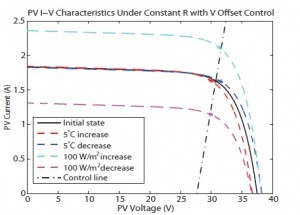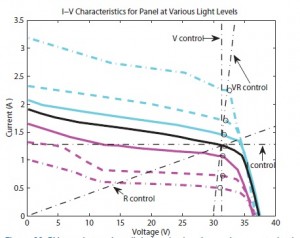Low Transient-Sensitivity Photovoltaic Control
Katherine A. Kim with adviser P. T. Krein

Figure 25. Lowest transient-sensitivity control line for typical PV irradiance and temperature changes.
Grid-connected residential PV systems play an increasingly important part in today’s energy market, especially as the number of systems in use continues to grow. PV control schemes that maintain maximum power output under any environmental condition, as well as under transients, are required for these systems to be effective and reliable. While there are numerous MPPT algorithms, little attention has been paid to examining the PV’s natural electrical characteristics and developing a control scheme that has inherently low sensitivity to typical irradiance and temperature changes.
This research introduces a PV control scheme using constant resistance with a voltage offset that shows low irradiance and temperature transient sensitivity, and compares performance to other typical PV control schemes: constant-voltage, constant-current, and constant-resistance control. Using equivalent circuit models of a crystalline PV panel and typical temperature and irradiance changes, a voltage offset and resistance line with the lowest sensitivity, i.e., closest to the new MPP after a transient, can be calculated as shown in Figure 25. This new control scheme, in addition to the traditional control schemes, was tested on a PV panel at different irradiance levels using an electronic load. Results are summarized in Figure 26. A control line that maintains operation closest to the maximum power point after the transient will generate the most power. The voltage-offset-constant-resistance control showed best performance with constant-voltage control as a close second.
This research was funded by Grainger Center for Electric Machinery and Electromechanics.
